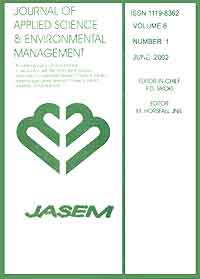
|
Journal of Applied Sciences and Environmental Management
World Bank assisted National Agricultural Research Project (NARP) - University of Port Harcourt
ISSN: 1119-8362
Vol. 20, No. 4, 2016, pp. 1027-1032
|
 Bioline Code: ja16108
Bioline Code: ja16108
Full paper language: English
Document type: Research Article
Document available free of charge
|
|
|
Journal of Applied Sciences and Environmental Management, Vol. 20, No. 4, 2016, pp. 1027-1032
| en |
Identification of Land Areas Suitable for Fadama Farming at Federal University of Agriculture, Abeokuta, Nigeria using GIS
UFOEGBUNE, G.C. & FABIYI, S.
Abstract
Fadama farming provides a platform for sustained crop cultivation during dry season. This research
was directed towards identifying new land areas within the Federal University of Agriculture with the use of
Geographical Information System (GIS). The few existing Fadama sites within the study area were searched and their
corresponding sizes were determined and represented in a map, using the tool of GIS. The drainage map of the study
area was also created using Arcview. Proper digitizing and geeoreferenceing was done for the study area using GIS
software and further GIS operations such as overlay and buffering were performed. The data from these operations were
finally superimposed with the soil series of the study area to identify new land areas that were suitable for Fadama
farming. The results produced a total of 21 areas suitable for Fadama farming in the study area. The result eventually
revealed the capacity of Geographical Information System and how its analysis enable us to interpolate, combine and
compare this spatial data to achieve the aim of site selection. It helped to identify new sites that can be used for Fadama
practise expanding the scope of Fadama farming in the Federal University of Agriculture Abeokuta ultimately
enhancing revenue generation and the society’s need for food security. Management of these wetland ecosystems
requires an understanding and mapping of the spatial distribution of their resources and how they are current being
utilized. The geographical information system is a tool for agriculturists to utilize its potential for future production.
|
| |
© Copyright 2016 - Journal of Applied Sciences and Environmental Management
|
|
